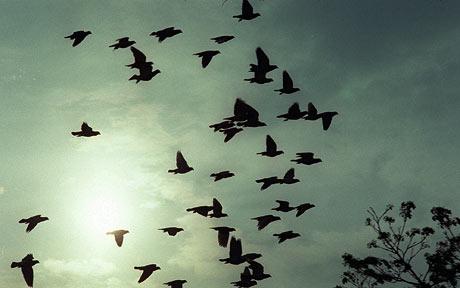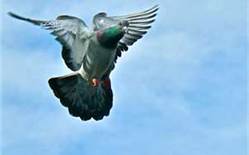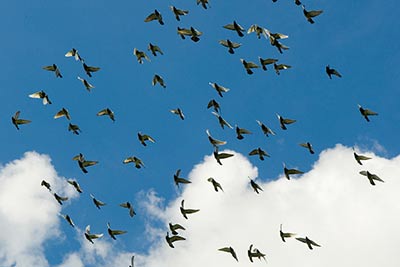Sunlight and the
elevated flight
Sunlight is a basic requirement for
all birds and it is easy to see the
positive effect that the sun has on
the health and well being of our
pigeons. On sunny days the birds look
so much brighter and more alert than
on overcast or wet days when the birds
look depressed and disinterested.
It is known that direct
sunlight provides birds with the
vitamin D, that is so necessary for
bone, feather and reproductive health,
but it must have other positive
effects on the metabolism and immune
system, because the birds look so
strong when they have access to direct
sunlight. For this reason, it is
recommended that every bird in the
loft has access to direct sunlight.
This is best achieved by an elevated
flight.
The elevated flight is
ideal for baths, protecting the loft
from wetness and the race birds from
potentially harmful ground germs
associated with free lofting. The
elevated flight is usually opened
directly to the breeding loft, whereas
the flight of the race loft must be
closed off at night from the rest of
the loft during the race season. The
flight quickly becomes a favourite
rest and recreation area for both the
breeding and race birds, playing an
important part in strengthening the
loft bonding process of pigeons.
Security and rest at
night
The special attention that is given to
providing the pigeons with a loft that
promotes complete rest at night will
reward the fancier with a healthier
flock and more consistent race
results. Both the breeding and race
lofts must protect the birds from
moisture, temperature extremes, too
little or too much air movement,
predators, noise, fumes, light and
other disturbances, so that the birds
can rest, especially at night. Proper
rest is a major pre-requisite for
continuing pigeon health and race
performance.
The breeding loft
The design requirements of the
breeding loft are simple compared to
the race loft. The best breeding loft
is very open, because breeding takes
place during the warmer months. At
night the birds usually rest
comfortably in their nest boxes and
during the day a large open flight
provides the adults and babies in the
nest with the health benefits of
direct sunlight. The open breeding
loft improves the circulation of fresh
air and promotes a drier loft, which
in turn improves the breeding
performance. Breeding is far less
stressful to the pigeon than racing
and maintaining their health is so
much easier, because the birds are not
exposed to the outside diseases and
hardships of the race basket.
The race loft
The race birds are exposed to many
more stresses than the breeders and
require much more rest to remain
healthy. Consequently, the
requirements for a successful race
loft are more exacting and complicated
than for the breeding loft and must
provide the race team with the
necessary rest to recover from their
strenuous physical exertions. The
darkness of night provides the pigeon
with the time to rest and the
conditions in the loft at night are of
the utmost importance if the pigeon is
to fully recover from the exertions of
the previous day.
The
conditions inside the race loft which
promote restful sleep at night are:
- No rapid
fluctuations of humidity and
temperature. Good ventilation (i.e.
the air circulation is good, the air
is fresh, not heavy or stuffy, no
drafts and no dust). The pigeons
numbers are controlled i.e. no
overcrowding. There is no wetness in
the loft.
- The loft
is clean.
Temperature and
humidity control
To protect the fit racing pigeon from
losing form, the temperature in the
loft must be above 10 and below 30
degrees Celsius, and the humidity kept
below 65%. These are the conditions
that favour continuing health and
known as the thermo-neutral zone for
the pigeon.
In most lofts, it is the
humidity, more than the temperature,
which determines whether the birds
rest or not at night. Humidity
measures the amount of moisture in the
air, irrespective of the air
temperature, but it is the high
humidity (greater than 65%) associated
with a temperatures below 15 degrees
Celsius that most affects the pigeons
ability to rest. The pigeon loses form
and becomes susceptible to illness
when it does not to get adequate rest.
The droppings in the loft
are the best indication of the
humidity levels. In the healthy loft,
a low humidity (less than 55%) gives a
consistently nutty brown dropping,
whereas a higher humidity (greater
than 65%) will produce green watery
droppings. At night-time, when the
pigeons need to rest, there is always
a rise in the humidity, because as the
temperature drops the humidity rises.
This explains the droppings turning
wet and green the morning after a cold
humid night, but which then turn nutty
brown by the afternoon as the day
warms up and the humidity drops. No
two lofts, even if they are identical,
will have the same humidity levels,
because the humidity inside the loft
relates directly to the humidity
outside the loft. The controlling
factor of humidity is the location (or
geography) of the loft. Often fanciers
will re-create their previously
successful loft design when they move
from one house to another but find
that they are no longer successful
flyers. The only difference is the
location of the loft.
High
humidity risk lofts:
These lofts require a
loft design that stops the outside
humidity (moisture) entering the loft.
Insulation is the first
step to controlling fluctuating
temperatures and high humidity inside
the loft. It is the moisture drops of
condensation appearing on the inside
of uninsulated walls and ceilings that
increase the humidity inside the loft
to the very high levels that
predispose the race birds to
restlessness and respiratory
illnesses. The insulation of the walls
and ceiling will stop this
condensation and allow you to control
respiratory diseases with the minimal
use of medicines.
In high humidity areas,
shutting the loft up at night or when
it is raining is a good method of
controlling the humidity inside the
loft (louvres are commonly used), but
the air circulation and the air
quality inside the loft must not be
compromised. Too often the loft is
completely shut up with no thought
about air circulation. The resulting
stale loft makes the race birds
lethargic due to lack of oxygen.
Heaters at night are
beneficial for the race team. The
healthy team remains in top form when
the loft is closed at night by keeping
it warm and dry. However, it is better
to have a very open loft in flocks
recovering from respiratory disease to
prevent the "respiratory" germs
accumulating inside the loft from
re-infecting the race birds.
Oil based bar heaters are
safe and effective to use when the
temperature drops below 12 degrees
Celsius and are used to prevent a loss
of form by keeping the air and dry.
Dehumidifying machines are also
available, but the noise may prevent
the birds from full rest.
Hygrometers can be
installed to monitor the humidity
within the loft, but often the salts
in the grit or mineral powder are
equally effective in monitoring
humidity above 65%. These salts
attract moisture. For example, F-vite
darkens and becomes granular when the
humidity is too high and grits become
dark and wet with moisture.
Ventilation
When the air inside the loft is not
as fresh as the outside air, then
there is a ventilation problem.
The traditional
Australian loft is open at the front
and gets good race results in areas
with low humidity (non-coastal and
inland regions, South Australia etc.).
Such a loft requires little other
ventilation other than vents on the
back and side walls of the loft. Place
the vents under the perches rather
than at the top, so that the air does
not pass over the birds resting in the
perches. The flow of air over the
birds created by incorrectly placed
vents is referred to as a draft and
causes illness by preventing the birds
from resting.
The creation of proper
ventilation in enclosed lofts is more
difficult to achieve and in dry areas
it is often better to avoid enclosed
lofts. However, in high humidity and
very cold areas the loft must be
enclosed at night to maintain the form
of the fit race team, although it is
opened up as much as possible during
the day. The best lofts can be opened
up during the day and closed up at
night, when it is raining or during
cold humid weather.
More ventilation is
required in closed lofts than open
lofts. Ceiling or wall ventilation
fans are often used to improve the
circulation inside the loft. Vents
placed on the back and side walls near
the floor are open during the day and
on warm nights and closed when it is
wet or cold. Double-check the quality
of the air inside an enclosed loft by
asking an asthmatic friend to stand
inside and pass an opinion as to the
freshness of the air.
Pigeon numbers
Overcrowded lofts do not race to their
true potential. Overcrowding increases
fighting, creates restlessness and
increases the staleness of the air.
Overcrowded lofts have consistently
good droppings, although the birds may
be healthy. Often healthy nutty
droppings return when the numbers are
decreased. The best race results occur
when the numbers are kept around 25
birds per 6 foot x 6 foot by 6 foot
loft.
Wetness in the loft
Waterproofing the loft is a priority,
because wet floors endanger the health
of the birds. Fit race birds
immediately lose form and often
succumb to coccidiosis three days
after the floor gets wet. Disinfecting
or cleaning the loft using water must
be reserved for warm days or allowed
to dry whilst the birds are out
exercising. Concrete slabs hold water
and are not recommended for race lofts
and must be designed to drain and dry
quickly when used beneath elevated
flights during the race season.
Clean loft
Pigeons love a clean loft and rest
better when the perches and floor are
cleaned free of droppings. Sand on the
floor looks good, but is not
recommended during the cold months of
the racing season. At this time the
birds may suddenly over-engorge on it
and lose form because of the resulting
"gut ache". Pigeons love to lie down
on straw but it must be perfectly
fresh, clean and be free of dust or
moisture. Black marks and a musty
smell to the straw indicates mould on
the straw, which can damage the
pigeons airsacs when inhaled.
The loft is cleaned at
least once and even better twice daily
during the racing season.
Twice daily cleaning
allows the fancier to monitor the
health of the race team very closely.
A change in the droppings is then
recognised very early and the
appropriate remedy (either rest, water
cleanser, medicines, loft heaters
etc.) can be quickly and effectively
prescribed. The design of the loft
must be such that scraping is made as
easy as possible. The floor should be
perfectly flat and smooth and the
perches must be wide enough and
brought out from the wall for easy
scraping.
Loft position
The best lofts are positioned in the
yard to get the most amount of
sunlight from the day during the
racing season. In Australia, the best
direction to face the loft is between
North West to North East, because the
sun moves northward during the winter
months of racing. Lofts need as much
sunlight as possible. They also need
space to breathe fresh air and are
best away from trees, fences and be
elevated.
The resting pigeon
The best designed lofts create an
environment that is so relaxing that
during the day and at night-time the
birds lie down on the ground or on the
perch with their wings hanging loose.
The compartment sizes should not be
too large, but small and low enough
for the fancier to catch the birds
easily without chasing them around the
loft. The race team is tamer and more
relaxed in a loft with smaller
compartments. The best size sections
are 6 inches higher than the fancier,
6 feet deep and 5 feet wide.
Loft materials for
ceilings, walls and floors
In high humidity areas the ceiling and
walls of the pigeon loft must be lined
if consistent racing results are to be
enjoyed. Masonite and wood are better
insulators than metal. The best floor
for racing is made of wood (form ply
or marine ply) because it is a good
insulator, stays warm, and is smooth
for effective scraping. It can be
unscrewed and replaced with wired
floors during the off season if
required. Wood floors are harder to
disinfect. Concrete floors are not
recommended in the race loft because
they are cold and retain moisture, but
they are good for the breeding loft
and can be used for the race loft if
they are centrally heated. In high
humidity areas wire floors are not
recommended for racing because the
droppings beneath the wire accumulate
moisture and grow fungus, which causes
moulding disease. They are acceptable
in dry areas and during the breeding
season, but must be treated for fungus
and insects regularly.



